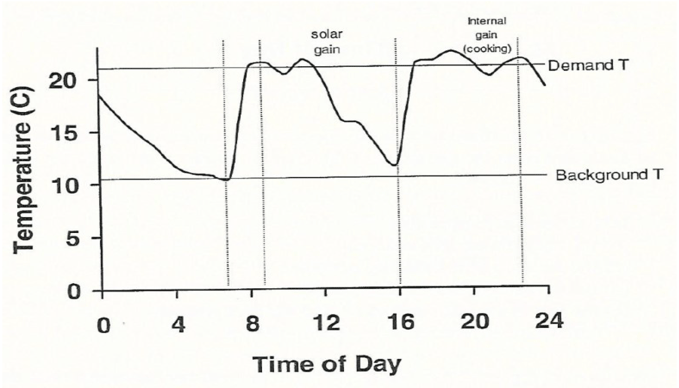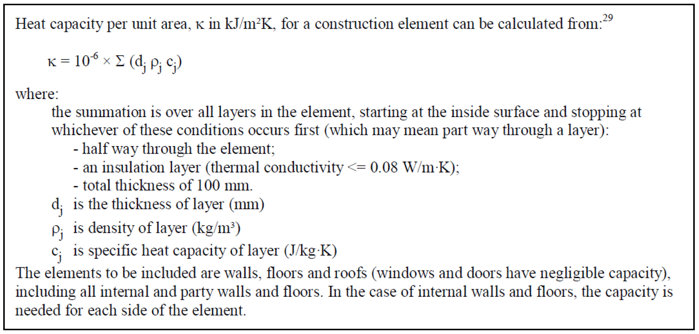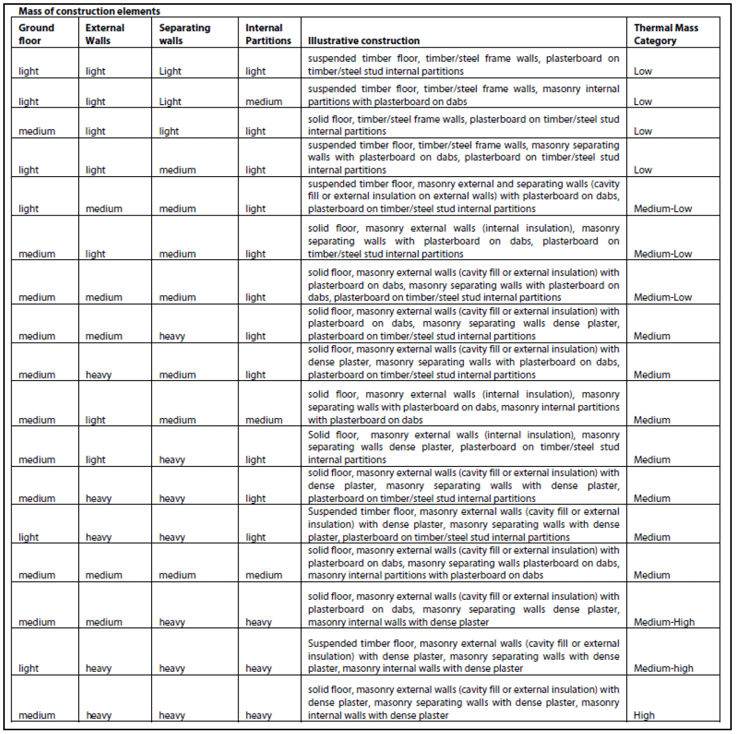Domestic and non-domestic energy performance certificates review: supplementary notes
Notes supplementing analysis of responses to our three public consultations about energy performance certificates (EPCs).
3. Thermal Mass
The thermal Mass, or the internal heat capacitance, of a material reflects its ability of to absorb and store heat. Materials with high thermal mass will take longer to warm up, but longer to cool down. Thermal mass is not a substitute for insulation. Many materials with a high thermal mass are very poor insulators, for example, dense stone and concrete; many materials with good insulation properties have a low thermal mass.
Within building design and construction, thermal mass provides a buffer against rapid fluctuations in temperature: the thermal mass will absorb thermal energy when the surroundings are higher in temperature than the mass, and then transfer the stored thermal energy back when the surroundings are cooler. The appropriate use of thermal mass can make a considerable difference to internal comfort, and heating and cooling bills. In the winter, it can help the dwelling maintain comfortable temperatures, and in the summer, thermal mass can assist in preventing a building over-heating. However, thermal mass is not a 'free' heat source. If there is no heat input into the thermal mass, there is no heat to transfer back into the surrounding environment.
How effective thermal mass is at improving comfort conditions represents a trade-off between the type of heating in the property, the use of the heating, and the position of any insulation. It is not a simple equation that high thermal mass is good. For example, the benefits of the thermal mass may be negated by the placement of insulation or other low thermal capacitance materials between the heat source and the thermal mass. So, carrying out internal wall insulation in an otherwise high thermal mass stone-built property will effectively negate any benefits that the thermal mass may offer.
3.1 Temperature Profile
The modern common practice of intermittently heating the home works against realising the benefits of the thermal mass, as the heating system may not be used for long enough for the building fabric to warm up (i.e. to fill the thermal store of the fabric), despite the air temperature coming up to a desired temperature. Dwellings of low thermal mass (i.e. they warm up quickly when the heating is turned on) are more suited to use of intermittent heating. By contrast, the use of heating in stone-built dwellings in the past, where open fires were common, and which may have been kept burning continuously (if only in a dampened down state when the occupants were out or overnight to avoid the laborious task of having to re-light the fire from scratch) provided sufficient heat input to keep the fabric warm.
SAP and RdSAP are based on a model of intermittent use of heating in the home. This is shown in Figure TM1: the temperature trace shows the effect of heating coming on in the morning, the internal temperature rises; the heating then goes off, and the internal temperature drops through the day though benefiting from incidental solar gains; the heating comes on again in the evening, the internal temperatures rise again and are maintained through the evening until the heating goes off, and the temperature falls overnight. The whole process starts again the next day.
Unresponsive systems (e.g. electric storage heating or solid fuel systems) work better with dwellings with high thermal mass in SAP and RdSAP because they are assumed to provide a heat input into the dwelling outside of the defined heating period.
Figure TM1: Intermittent Heating Daily outside the formal heating period

3.2 Calculating the Thermal Mass Parameter
Within RdSAP, the heat loss calculation assumes a default Thermal Mass Parameter of 250 kJ/m2K for all dwellings, that is, medium thermal mass. In the full SAP program, you can select high, medium, or low thermal mass, or choose to calculate the thermal mass parameter. The SAP 2012 manual provides the description and equations to carry out the calculation (see Figure TM2 and Figure TM3 below)
Figure TM2: Calculating the Thermal mass parameter (source: SAP 2012)

Figure TM3: Calculating the Heat capacity per unit area (source SAP 2012)

In Figure TM3, the guidance sets out some quite explicit considerations when calculating the heat capacity per unit area of a material, for example, when the internal heat capacity of a stone wall was being calculated. Ending the calculation at 100mm of the wall is likely to occur before you were halfway through a common stone wall of 600mm thickness or more. If the stone wall had a lath and plaster internal finish, then very little of the actual stone would be taken into account as much of the 100mm in the calculation of the heat capacity per unit area of the wall would be taken up by the more lightweight lathe and plaster components of the wall construction.
Importantly, when it comes to calculating the thermal mass parameter for the whole dwelling, it is not just the external wall(s) that is/are taken into consideration, but also the internal partition walls within the dwelling, the party walls, the ground floor, any intermediate floors, and the roof. So even if stone walls were plastered on the hard with a dense plaster, the high thermal mass of this part of the fabric would be mitigated against by the suspended timber floor construction and the ceiling to the loft. It can be seen from Figure TM4 over the page, that it takes more than the external walls having a high thermal mass for a dwelling to be scored as high thermal mass overall.
Figure TM4: Categorising a Dwelling's Overall Thermal Mass Source: DEAP 3.2.1 – Table S10[12]

3.3 The Impact of Changing the Thermal Mass Parameter
Utilising one of the archetypes[13] from the REEPS analysis[14], the thermal mass parameter was assessed respectively as being high, medium, and low for two different heating scenarios – a gas boiler wet central heating system, and an electric storage heating system. The results are set out in Table TM1.
Table TMI: Summary of the impact of changing the thermal mass parameter on a property for two different types of heating
| Gas Condensing Combi Boiler | Electric Storage Heating | |||||
|---|---|---|---|---|---|---|
| High TMF=450 | Medium TMF=250 | Low TMF=100 | High TMF=450 | Medium TMF=250 | Low TMF=100 | |
| SAP | 48 | 51 | 55 | 24 | 26 | 27 |
| EI | 41 | 44 | 47 | 11 | 12 | 13 |
| Space Heating Consumption (kWh/year) | 26869 | 24649 | 22329 | 25823 | 25025 | 24430 |
| Space heating Fuel Costs (£/year) | £935.05 | £857.76 | £777.03 | £1799.50 | £1743.87 | £1702.38 |
Changing from medium to low thermal capacitance increased the SAP and EI scores, and reduced the space heating fuel consumption and fuel costs for both heating scenarios. Switching from medium to high capacitance resulted in lower SAP and EI scores, and higher fuel consumption and fuel costs for both heating scenarios. The difference between the results for the two heating systems (i.e. the magnitude of the increases and decreases as thermal capacitance changed) was within a much narrower range with the electric storage heating than with the gas central heating: ±2 points on the SAP score compared to ±4 points for the gas system; ±1 point on the EI rating compared to ±3 points with the gas system; ±803 kWh on energy consumption compared to ±2320 kWh with the gas system; and ±£46 on the fuel bill compared to ±£80 with the gas system.
The thermal pass parameter was varied across the top 105 archetypes from the REEPS analysis (in terms of the number of dwellings of each archetype represented), which included all of the archetypes representing 1300 dwellings or more, and over 62% of the private sector dwelling stock scoring less than SAP Band D as derived from the SHCS surveys between 2010 and 2013. Only 2 of the 105 archetypes did not follow the pattern seen in Table TM1, that is, switching to low thermal mass improved the energy performance indicators, while switching to high thermal mass made them all poorer. Both of these properties were sandstone flats with electric heating. An overall summary of the impact of changing the thermal capacitance is set out in Table TM2.
Table TM2: Summary of the Impact of switching the thermal mass parameter (n=105)
| Range of impact | Mean impact | |
|---|---|---|
| SAP medium TM to low | -0.18 to +5.52 | +2.828 |
| SAP medium TM to high | -0.12 to -4.87 | -2.619 |
| EI medium TM to low | -0.19 to +4.39 | +2.523 |
| EI medium TM to high | -0.12 to -3.65 | -2.272 |
| kg CO2 medium TM to low | -1560 to +21.6 kg CO2 | -555 kg CO2/year |
| Kg CO2medium TM to high | -13.6 to +2103 Kg CO2 | +554 kg CO2/year |
| Total £ medium TM to low | -£294.00 to +£2.89 | -£93.15/year |
| Total £ medium TM to high | +£1.89 to +£351.00 | +£89.88/year |
| kWh medium TM to low | -7765 to +127 kWh | -2684 kWh/year |
| kWh medium TM to high | -81 to +8126 kWh | +2643 kWh/year |
The heating systems in these archetypes was categorised by either being responsive (i.e. gas, LPG or oil central heating system with radiators) or unresponsive (i.e. electric storage heating, or solid fuel wet central heating or coal fires. As seen in the results for the single archetype in Table TM1, there is a much narrower range of change across all the indicators in the dwellings with the unresponsive heating systems (see Table TM2).
Table TM3: Summary of Impact of switching thermal mass parameter (n=105): heating system type
| Mean Impact Wet Central heating | Mean Impact Unresponsive Heating | |
|---|---|---|
| SAP medium TM to low | +3.61 | +0.85 |
| SAP medium TM to high | -3.29 | -1.03 |
| EI medium TM to low | +3.20 | +0.75 |
| EI medium TM to high | -2.86 | -0.90 |
| kg CO2 medium TM to low | -735 kg CO2/year | -171 kg CO2/year |
| Kg CO2 medium TM to high | +721 kg CO2/year | +219 kg CO2/year |
| Total £ medium TM to low | -£124.18/year | -£21.41/year |
| Total £ medium TM to high | +£118.63/year | +£26.92/year |
| kWh medium TM to low | -3495 kWh/year | -885 kWh/year |
| kWh medium TM to high | +3373 kWh/year | +1137 kWh/year |
Rather than adopt a single thermal mass parameter in the full SAP analysis of these archetypes, a variable thermal mass parameter was used. All stone dwellings (both sandstone and granite) were assumed to be of high thermal mass as were the two system-built dwellings; the solid and cavity brick dwellings were assumed to be medium thermal mass; and the timber frame dwellings were assumed to be low thermal mass. The effects of using a variable thermal mass parameter are compared against the results of the default medium thermal mass parameter (see Table TM4).
Table TM4: Comparing results for Medium Thermal Mass Parameter against Variable Thermal Mass Parameter (n=105)
| Medium Thermal Mass mean | Variable Thermal Mass mean | Impact | |
|---|---|---|---|
| SAP | 41.00 | 39.64 | -1.35 |
| EI | 31.97 | 30.83 | -1.14 |
| kg CO2 | 9154 kg CO2/year | 9467 Kg CO2/year | +312.8 kg CO2/year |
| Total £ | £1558 /year | £1609/year | +£51.47/year |
| kWh | 45648 kWh /year | 47081 kWh/year | +1433 kWh/year |
For the dwellings assessed, using a variable Thermal Mass Parameter would reduce the SAP score by 1.35 points, reduce the EI rating by 1.14 points, and increase the CO2 emission figures, fuel costs and energy consumption figures. However, it must be noted that this sample of archetypes was heavily biased towards dwellings with stone constructions, and therefore with a heavy thermal mass (50 of the 100 archetypes were stone built). By contrast only 5 of the 100 were timber frame, and therefore considered to be of low thermal mass. In the Scottish dwelling stock there is a considerable larger share of timber frame dwellings than 5%.
Switching to a variable Thermal Mass parameter could be done in one of two ways:
- first, it could be built as a default into the RdSAP software. The identification of the wall construction in RdSAP includes all of the options here and a few more, that by selecting it, RdSAP would assign an appropriate Thermal Mass parameter automatically.
- alternatively, the assessors could identify the thermal mass from something like the Thermal Mass Category Table presented above in Figure TM4.
Contact
Email: Steven.Scott@gov.scot
There is a problem
Thanks for your feedback